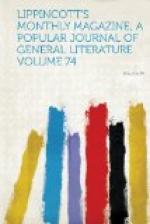Like rivers colored by the soil through which they flow, religions often change their characteristics according to the nations who practice them. The Raskol is Byzantine Christianity issuing from the Russian lower classes. In the thick and muddy waters of Muscovite sectarianism we can distinguish foreign admixtures, sometimes Protestant, sometimes Jewish, or even Mohammedan, more frequently Gnostic or pagan. The Raskol, nevertheless, remains wholly different, in principle and in tendency, from all the religions and religious movements of the world: it is original and national from the foundation up. So thoroughly Russian is it that outside of its native country it has never made a proselyte, and even within the empire has hardly any adherents excepting among the people of “Greater Russia,” the most thoroughly national of all. So spontaneous has been its growth that in all its phases it is its own best interpreter, and if confined to an isolated continent, its development would have been the same. The Raskol is the most national of all the religious movements to which Christianity has given birth, and at the same time the most exclusively popular. It took its rise, not in the schools, nor in the monasteries, but in the mujik’s hovel and in the shop; and it has never spread beyond its birthplace. Hence, the student of politics and the philosopher take a keener interest in ignorant heresies than is to be found in their doctrines alone. These sects of lately-liberated peasants claim an attention by no means due to their meagre theology, from their being the symptom of a mental condition and a social state for even a distant approach to which all Western Europe would be scoured in vain.
The Raskol (schism) is neither a sect nor a group of sects. It is, rather, an aggregate of doctrines and heresies, which are often divergent or even contradictory, with no other tie than a common starting-point and a common hostility to the official orthodox Church. In this respect the Raskol is more nearly analogous to Protestantism than to anything else. It is inferior to Protestantism in the numbers and education of its adherents, but it almost equals it as regards the variety and originality of its developments. Further the likeness cannot be fairly said to go. In the midst of their unfilial revolt, German Protestantism and the Russian Raskol preserve alike the signs of their origin, the stamp (so to speak) of the Church whence they have issued, as well as of the widely-differing states of society which gave them birth. In Western Europe love of speculation and a critical spirit gave rise to the larger part of modern sects, while in Russia they are the offspring of reverence and unenlightened obstinacy. In the West, the predominance of feeling over the value attached to the externals of religion has been the cause of religious divisions, whereas the same result has been produced in Russia by an extraordinary reverence for external forms for ritual




